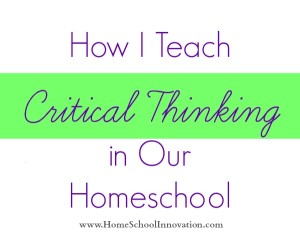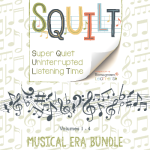Critical Thinking is an essential part of learning. In order for us to be resilient and successful in life we need to be able to gather facts, process through them, know if we require any more information or help, and then make a decision to move forward.
Learning how to “Think it Through” helps us in all areas of life:
-
Academics
-
Relationships
-
Business
Not to mention all the other little bits of life which happen in between the above three areas. It is because of this I try my best to implement as much Critical Learning into our day as possible. Although you do want to be careful not to overdo it, sometimes it is worth disguising it into the natural rhythm of your day v.s. always trying to make a point of “thinking it through” with your children.
This is a big topic, so I am going to give you a basic peek into what critical thinking is as well as how go about teaching it everyday in our home.
Critical Thinking…What is It?
Critical thinking is a way of deciding whether a claim is true, partially true, or false. Critical Thinking is a process that leads to skills that can be learned, mastered and used. Critical Thinking is a tool by which one can come about reasoned conclusions based on a reasoned process. This process incorporates passion and creativity, but guides it with discipline, practicality and common sense. It can be traced in the West to ancient Greece with its Socratic method and in the East to ancient India with the Buddhist kalama sutta and abhidharma literature. Critical thinking is an important component of education, politics, business, and science. https://en.wikipedia.org/wiki/Critical_thinking
When we learn critical thinking, we are learning to think about things more skillfully as well as always reaching for a higher quality of thought. Once we develop our own questions to dig deeper into a subject we can then develop and support our own conclusions.
How I Teach Critical Thinking
I ask my kids lots of questions, good process questions; some of these are in very obvious ways and sometimes it is as natural as a basic conversation.
If you are new to this concept of teaching/parenting you will have to make a conscious effort to implement some of these process questions. After a while you will find it will start to flow as a natural teaching method.
What are Process Questions?
Process questions are questions you can ask which will:
-
Focus Attention
-
Force Comparison
-
Seek Clarification
-
Invite Further Inquiry
-
Seek Reason or Explanation
Now that you see what process questions are think of the academic subjects we learn/teach.
-
All subjects and conversations we have require us to also know how to give focused attention.
-
What subjects do you think require us to compare data? How can we then clarify that data?
-
Can you dig deeper into said data and come up with some more questions about it?
-
Now that you have dug deeper and thought about more questions and answers, what conclusion have you come to?
Breaking Critical Thinking Down in our Homeschool
You can use critical thinking in every subject area, here are some examples of questions I ask my kids while teaching certain subjects.
Math:
-
Do you notice a pattern here? (Focus)
-
When have you used addition other than in your Math book? (Further Inquiry and Real Life application)
-
Tell me how you did that? (Seek Reason/Explanation)
Spelling:
-
What other words do you know which have a “tion” ending (Further Inquiry)
-
What does that ‘e’ do at the end of the word? (Seek Clarification)
-
Do you notice there are letters you cannot hear when you say this word? (Focus)
Science:
-
How can we find out the mass? (Further Inquiry)
-
How is _____different/same as _______ (Comparison)
-
What is your evidence? (Seek Reason/Explanation)
Reading Comprehension/Family Read-a-Louds
-
Look at this picture, what do you think the story is about? (Focus)
-
What do you think “Johnny” will do to help his friend? (Further Inquiry)
-
Why do you think that? (Seek Reason/Explanation)
As you can see with some of the process questions I ask, you really can include elements of critical thinking in all that you do, don’t forget to incorporate it into your Art and Music study as well. In fact, we often ask these types of questions in the conversations we are having with each other and don’t always recognize it as a lesson in critical thinking.
What Else Can You Use?
Every once in a while the kids and I pull out these “Mind Benders” books from Critical Thinking Co.
*affiliate link to products we use in our homeschoolWe get out some scrap paper, pencil and eraser and get started on solving some of these mind benders. They can be lots of fun, but also gives us as parents a chance to guide our children through a problem.
How to Teach Mind Benders:
-
Use process questions
-
Give your child time to think, don’t rush
-
Have them support their train of thought
-
Mistakes happen, ask more questions to get back on track
-
Have fun















Love these ideas! We love using logic workbooks and puzzles from Critical Thinking. I was just looking online last weekend for some additional critical thinking resources. Thanks for sharing!
You are welcome! We have fun with our “Mind Benders”, I hope you do too!
Great post, you! Love the breakdown on using the technique for each subject!
Thank you so much Tania!
Great post Angela – lots of good wisdom here, thank you
I also love how you give so many specific examples for helping our kids to think critically. We love the Mind Bender puzzles. And we also love the Fallacy Detective books. But you’ve given us ideas for how to incorporate critical thinking into the rest of our day. Thanks so much!
You are welcome Michelle!